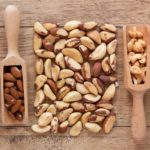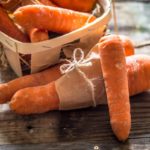
Tiana Hape-Cramond
(Associate Registered Nutritionist)
Eggs are a valuable source of protein, essential amino acids, vitamins, minerals, and healthy fats. By understanding egg farming, we can make choices that align with our health, ethical, and environmental priorities.
Eggs have become a staple in most households in New Zealand. There are different methods of egg farming such as:
- colony cages
- barn farming
- free range
- organic
We’ll look at these farming systems in more detail, as well as how they impact the quality of eggs from a nutritional standpoint.
The Colony Cage Environment
Colony cages are an alternative to battery cages as there were concerns about the welfare of hens. Colony cages were introduced to New Zealand in the early 2000s as they were becoming increasingly popular in Europe.
As the industry began to phase out battery cages after 2012 many egg producers adopted colony cages to comply with new regulations.[1]
Farmer Brown was one of the first egg companies to introduce colony farming to New Zealand in 2013 to meet quality and welfare requirements.[2]
Colony cage environment provides space and features that allows chickens to nest, perch, scratch and stretch their wings by providing nesting boxes, perches and scratch pads.
Colony houses up to 60 hens
Also, it has a continuous moving belt that removes waste for hygiene and welfare.
Colony houses provide up to 750 square centimeters per bird and is structured like an open plan home where they have access to roam and interact socially.[3]
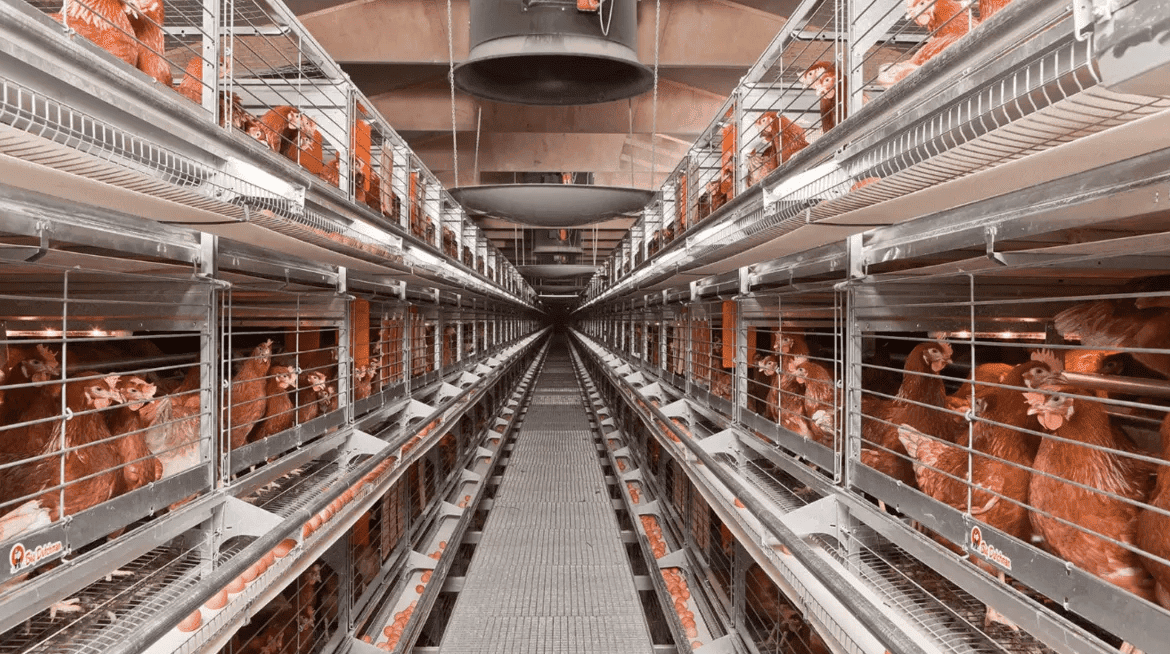
Source: SPCA
SPCA is opposed to colony farming. Although colony cages provide a larger area than battery cages, SPCA argues that the hens are not able to express normal behaviours.
However, the Ministry of Primary Industries states colony cages provide perches and scratch pads which allows chickens to express their normal behaviours.[4]
Barn Farming
In 1995, a farmer in Wairarapa saw battery hen operations and decided to change it. Henergy became New Zealand’s first barn-egg farm giving hens a safe and comfortable barn to produce eggs.[5]
Barn farming allows the hens to be housed in large sheds with litter on the floor. Hens are able to roost and sleep on perches and nesting boxes for egg laying are available.
Barn farming provides up to 1430 square centimeters per bird.[6]
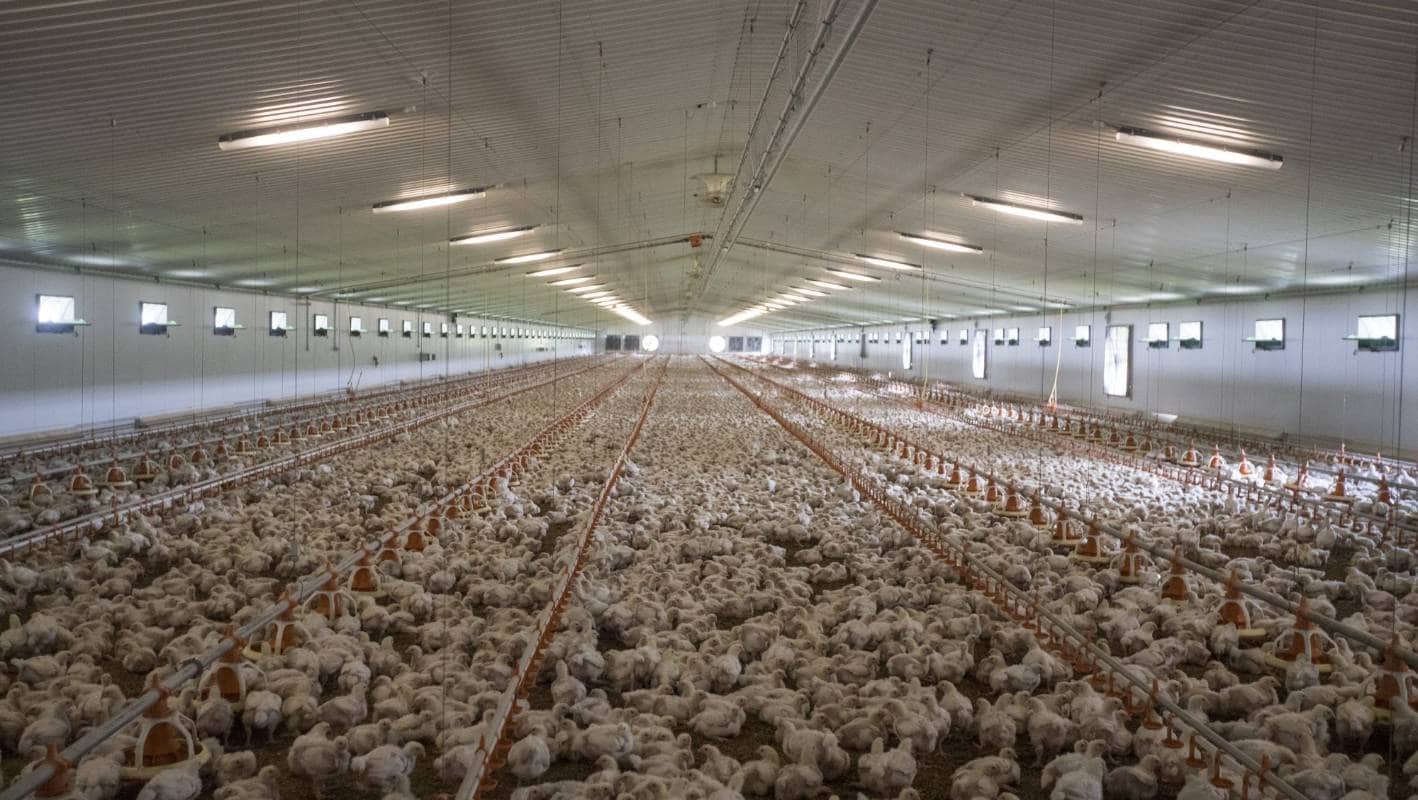
Barn egg farming allows hens to have the ability to roam inside the barn environment, access to food and water, access to perching, nesting and scratching areas, eight hours of darkness every 24 hours.
Barn egg farming is in compliance with Animal Welfare Code of Welfare 2018.[7]
Free-Range Egg Farming
Free-range farming provides hens access to the outdoors.
Hens are given a shelter that may be fixed or portable. On larger farms, flocks are housed in sheds that have nesting boxes and perches. Hens are able to access the outdoors through pop-holes in the wall.
Flocks sizes for free-range farming is dependant on the land size of the farm with a maximum of 2,500 hens per hectare.[8]
Free-range eggs are considered better quality
This is due to the hens’ ability to forage on natural vegetation and insects, which can enhance the nutrient profile of the eggs.
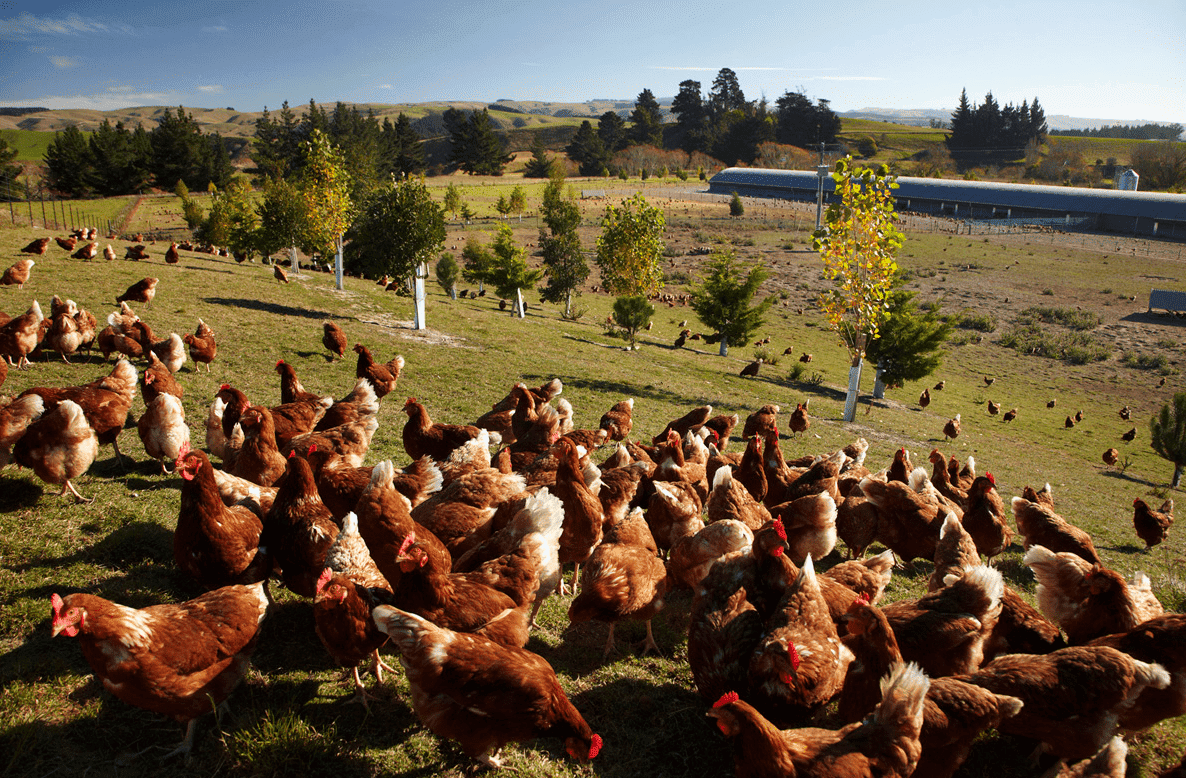
Source: Egg Producers Federation of New Zealand
As the hens are exposed to the outdoors they are more vulnerable to disease, predators, parasites and weather.
This means close monitoring and preventative measures to manage the health and welfare of the hens.[9]
Backyard Farming
In the early 20th Century, chickens were kept in the backyard of roughly half of New Zealand households.
Backyard farming is the practice of raising chickens in residential or small-scale setting to produce eggs for personal consumption.
When starting backyard farming it is important to consider hen housing, enclosures, feed and health of the hens.[10]
Consider local regulation and proper care to ensure the health and wellbeing of the hens and the quality of the eggs.
Organic Eggs
The hens are typically given access to the outdoors and are fed organic feed, which is free from synthetic pesticides, fertilisers, or genetically modified organisms (GMOs).
Hens are able to freely roam during the day and are housed safely and securely in sheds at night.
The term organic is given to products that are produced in accordance with organic production standards. All organic farms must comply with Animal Welfare Code of Welfare 2018, which is administered by MPI.[11]
Organic eggs are often perceived to have higher quality and better nutritional value due to the organic feed and more natural farming practices.[12]
Quality of eggs
The quality of eggs can vary due to the diet of the hens, quality of living conditions and farming methods.
Nutritional composition
The diet of hens plays a crucial role in determining the nutritional composition of eggs. Hens that are fed a balanced diet containing essential nutrients produce eggs with higher levels of vitamins, minerals, and omega-3 fatty acids.
For example, hens that are fed flaxseed produce eggs with higher omega-3 content.[13] Conversely, hens with a nutrient-deficient diet may lay eggs with lower nutrient levels.[14]

Housing environment
The living environment of hens can impact egg quality. There are different housing systems, including:
- conventional cages
- enriched cages
- free-range systems
- organic production
Chickens raised in conventional cages have increased stress and reduced immune function compared to those housed in enriched cages.[15]
Stressed hens may also experience hormonal imbalances, impacting their reproductive cycle and reducing their ability to lay eggs consistently.
Stress hormones, such as corticosterone, can interfere with the normal functioning of the ovaries, leading to decreased egg production or even temporary cessation of egg-laying.[16]
Stress can affect the quality of eggs
Hens raised in free-range or organic systems typically have access to outdoor areas where they can forage for insects, grass, and other natural food sources.
These hens tend to produce eggs with higher levels of certain nutrients, such as vitamin E and beta-carotene, due to their varied diet.
Additionally, free-range or organic systems may result in eggs with lower levels of cholesterol and saturated fat compared to conventional cage systems.[17]
Use of antibiotics
In New Zealand only a vet can prescribe antibiotics after they have inspected the animal in person. An antibiotic, zinc bacitracin, is routinely fed to birds throughout their lives to prevent necrotic enteritis.[18]
This is the only antibiotic that is used regularly. Other antibiotics are prescribed and given when there is a confirmed outbreak.[18]
Poultry Industry Association of New Zealand provides guidelines for the use of antibiotics in poultry.[19] Antibiotics are registered for use by the Ministry of Primary Industries and if any medication is used there is a stand down time to ensure there are no traces of antibiotics.[20]
The use of antibiotics in egg production can affect egg quality.
Some farmers administer antibiotics to prevent or treat diseases in hens. While this may have benefits for hen health, excessive or inappropriate antibiotic use can lead to antibiotic residues in eggs, posing potential risks to human health.
In contrast, eggs labelled as “antibiotic-free” or “raised without antibiotics” are produced without the use of antibiotics, which can be a preferable choice for consumers concerned about antibiotic residues.[21]
Health and Safety
The production method can also influence the safety of eggs. Proper hygiene and sanitation practices during egg collection, processing, and storage are crucial to prevent contamination with harmful bacteria like Salmonella.
Farming practices that prioritise cleanliness, regular testing, and quality control measures help minimise the risk of bacterial contamination, resulting in safer eggs for consumers.[22]
Colony cages are generally easier to maintain due to the confinement of the hens. Good ventilation and proper airflow are important to reduce the ammonia levels and maintain hygiene. Regular cleaning and disinfection of cages, feeders, and drinkers are crucial in preventing a buildup of pathogens.[23]
In barn systems hygiene involves regular cleaning of the barn and removal of waste and soiled litter. Management of litter or bedding material is important to prevent moisture from building up and minimise spreading pathogens.
Nesting boxes and roosting areas require regular cleaning and disinfection to maintain hygiene and prevent disease.[24]
Free-range farms should regularly check and maintain outdoor areas to ensure that they are free from excess mud, stationary water or other unsanitary conditions.
Sanitation is needed to minimise the presence of disease or potential contamination from other animals. Similar to barns nesting boxes and roosting areas require regular cleaning and disinfection.[24]
How to interpret egg labels and make informed purchasing decisions
When looking at purchasing eggs there is certain information that should be taken into consideration.
Egg size varies from 4 to 8 and these are:
- Jumbo (8): 68g
- Large (7): 62g
- Standard (6): 53g
- Medium (5): 44g
- Pullet (4): 35g
- Mixed grade – a selection of different sized eggs
Purchasing eggs based on size is for preference and price. Larger eggs often cost more and certain recipes may call for a certain size of egg.[25]
As stated above there are a number of different farming methods which are labelled on the product for the consumer to choose the method that suits them best.
Does chicken feed affect the production and quality of eggs?
Laying chickens require a balanced diet to maximise egg production. The quality of chicken feed may affect:
- egg weight
- egg shell thickness
- yolk colour
- quality of cooked yolk[26]
If feed does not have adequate amounts of vitamin D and calcium, egg production decreases.[27]
RELATED — Calcium (for healthy bones, teeth and heart)
Protein is required for hens to receive all their amino acid requirements. If dietary protein lacks, this results in poor egg production and hatchability will occur.[27]
Dietary fat provides hens with energy and linoleic acid. A deficiency in linoleic acid will affect egg production and impair the absorption of vitamins A, D, E and K.[27]
RELATED — Vitamin D: The sunshine hormone for stronger bones

A study found that laying hens that were fed canola seed and linpro (flaxseed and peas) diets had greater egg production and laying hens that were fed flaxseed had a greater omega-3 content.[28]
Related Questions
1. Does the colour of the egg shell affect the nutritional value?
No. The colour of egg shells is determined by the breed of hen. This has no effect on the nutrient content.[29]
2. Why are eggs expensive?
The price of eggs reflects the increase of costs to the farmers to produce eggs.
These expenses include the housing for the hens, farm maintenance to allow chickens to roam safely and freely, packaging and the cost of transport. Minimum wage increase may also affect the price of eggs.[30]
3. What are the nutrients in a chicken egg?
Eggs contain a large number of essential vitamins, minerals and antioxidants. These include:
- selenium
- vitamin B1 (Thiamine)
- vitamin B5 (Pantothenic acid)
- vitamin B7 (biotin)
- vitamin B9 (folate)
- vitamin B12 (cobalamin)
- vitamin A
- iodine
- vitamin E
- phosphorus
- iron
- zinc (for immunity, skin health and libido)
- vitamin D
- calcium
- lecithin
- choline
- lutein.[31]
If you are interested in reading more about particular nutrients, we have an entire topic called Nutrient of the month. You can find it in our section Connecting you with Food.
Tiana is an Associate Registered Nutritionist who has a passion for public health and education. Working towards a Master’s in Nutrition Practice with a Bachelor’s in Human Nutrition, Tiana has a personal interest in healthy heart nutrition and promoting positive lifestyle behaviours.
Tiana is a part of the Content Team that brings you the latest research at D’Connect.
References
(1) Why Furnished Cages in NZ? [Internet]. [cited 2023 Jul 1]. Available from: https://pianz.org.nz/wp-content/uploads/2010/11/Lorna_Craig_WPSA2010presentation.pdf
(2) Farmer Brown Gets Cracking With Colony Eggs | Scoop News [Internet]. Scoop.co.nz. 2013 [cited 2023 Jul 1]. Available from: https://www.scoop.co.nz/stories/BU1310/S00903/farmer-brown-gets-cracking-with-colony-eggs.htm
(3) EPFNZ. The Colony Cage Environment. Egg Producers Federation New Zealand [Internet]. Eggfarmers.org.nz. 2018 [cited 2023 May 16].
(4) SPCA. Colony cages: the struggle continues for chickens • SPCA New Zealand [Internet]. Spca.nz. 2023 [cited 2023 Jul 1]. Available from: https://www.spca.nz/news-and-events/news-article/colony-cages
(5) Henergy. Henergy, barn good eggs [Internet]. Henergy. 2015 [cited 2023 Jul 1].
(6) EPFNZ. Media information – Key facts and useful background on NZ egg farming | Egg Producers Federation New Zealand [Internet]. Eggfarmers.org.nz. 2016 [cited 2023 Jul 1]. Available from: https://www.eggfarmers.org.nz/farming-types/media-information-key-facts-and-useful-background-on-nz-egg-farming
(7) Trace My Egg [Internet]. Understanding New Zealand Barn Egg Farming. [cited 2023 May 16]. Available from: https://tracemyegg.co.nz/assets/Uploads/5b46014a78/NZ_Barn_Info_Sheet.pdf
(8) Free-Range. Egg Producers Federation New Zealand [Internet]. Eggfarmers.org.nz. 2018 [cited 2023 May 16].
(9) What are the best ways to protect my chickens from predators? [Internet]. Extension. 2019 [cited 2023 Jul 1]. Available from: https://extension.unh.edu/blog/2019/02/what-are-best-ways-protect-my-chickens-predators
(10) Egg Producers Federation New Zealand [Internet]. Backyard. Eggfarmers.org.nz. 2018 [cited 2023 Jul 1].
(11) Organic Eggs [Internet]. Tracemyegg.co.nz. 2018 [cited 2023 Jul 1]. Available from: https://tracemyegg.co.nz/about-the-codes-and-production-methods/organic-eggs/
(12) Yeh CH, Menozzi D, Áron Török. Eliciting Egg Consumer Preferences for Organic Labels and Omega 3 Claims in Italy and Hungary. 2020 Sep 1 [cited 2023 Jul 1];9(9):1212–2. Available from: https://www.ncbi.nlm.nih.gov/pmc/articles/PMC7554892/
(13) Province of Manitoba [Internet]. Increasing Omega-3 Fatty Acids in Eggs from Small Chicken Flocks. Province of Manitoba – Agriculture. 2013 [cited 2023 Jul 1].
(14) Ranil Coorey, Novinda A, Williams HJ, Vijay Jayasena. Omega-3 Fatty Acid Profile of Eggs from Laying Hens Fed Diets Supplemented with Chia, Fish Oil, and Flaxseed. 2014 Dec 29 [cited 2023 Jul 1];80(1):S180–7. Available from: https://ift.onlinelibrary.wiley.com/doi/abs/10.1111/1750-3841.12735
(15) Campbell AT, Johnson AK, Persia ME, Jacobs LJ. Effects of Housing System on Anxiety, Chronic Stress, Fear, and Immune Function in Bovan Brown Laying Hens. 2022 Jul 14 [cited 2023 Jul 1];12(14):1803–3. Available from: https://www.ncbi.nlm.nih.gov/pmc/articles/PMC9311790/
(16) Wang XF, Liu L, Zhao J, Jiao HC, Lin H. Stress impairs the reproduction of laying hens: an involvement of energy. 2017 Dec 1 [cited 2023 Jul 1];73(4):845–56. Available from: https://www.cambridge.org/core/journals/world-s-poultry-science-journal/article/abs/stress-impairs-the-reproduction-of-laying-hens-an-involvement-of-energy/6A528A51EE23C8BEA4B60DF951FF3F03
(17) English MM. The chemical composition of free-range and conventionally-farmed eggs available to Canadians in rural Nova Scotia. 2021 May 4 [cited 2023 Jul 1];9:e11357–7. Available from: https://www.ncbi.nlm.nih.gov/pmc/articles/PMC8103914/
(18) ThisNZlife [Internet]. thisNZlife. 2022 [cited 2023 Jul 1]. Available from: https://thisnzlife.co.nz/why-you-should-consider-the-gut-health-of-your-chickens-plus-how-to-improve-it/#:~:text=ANTIBIOTIC%20USE%20IN%20THE%20NZ%20POULTRY%20INDUSTRY&text=On%20many%20commercial%20broiler%20(meat,that%20live%20in%20poultry%20litter
(19) PIANZ. PIANZ Guidelines for the use of Antibiotics in Poultry | Poultry Industry Association New Zealand [Internet]. Poultry Industry Association New Zealand. 2018 [cited 2023 Jul 1]. Available from: https://www.pianz.org.nz/news/pianz-guidelines-for-the-use-of-antibiotics-in-poultry/
(20) Rangitikei Chicken [Internet]. Are Rangitikei chickens given antibiotics? Rangitikeichicken.co.nz. 2019 [cited 2023 Jul 1]. Available from: https://rangitikeichicken.co.nz/question/are-rangitikei-chickens-given-antibiotics/
(21) Owusu-Doubreh B, William Ofori Appaw, Abe-Inge V. Antibiotic residues in poultry eggs and its implications on public health: A review. 2023 Mar 1 [cited 2023 Jul 1];19:e01456–6. Available from: https://www.sciencedirect.com/science/article/pii/S2468227622003611
(22) Farming Standards | Egg Producers Federation New Zealand [Internet]. Eggfarmers.org.nz. 2018 [cited 2023 Jul 1].
(23) MPI – Ministry for Primary Industries. A New Zealand Government Department. [Internet]. Layer Hens – Code of Welfare www.mpi.govt.nz. Available from: https://www.mpi.govt.nz/dmsdocument/46036-Code-of-Welfare-Layer-hens
(24) How to clean the feeding line in a poultry housing (SI 12) [Internet]. Kaercher.com. 2023 [cited 2023 Jul 1]. Available from: https://www.kaercher.com/int/professional/know-how/cleaning-coops-for-chicken-and-other-poultry.html
(25) Egg Producers Federation New Zealand [Internet]. Egg Labelling. Eggfarmers.org.nz. 2018 [cited 2023 Jul 1].
(26) Lorenzo JM, Rois D, Arias A, José Sterza Justo, Martí-Quijal FJ, Sucheta Khubber, et al. Effect of Breed and Diet Type on the Freshness and Quality of the Eggs: A Comparison between Mos (Indigenous Galician Breed) and Isa Brown Hens. 2020 Mar 16 [cited 2023 Jul 1];9(3):342–2. Available from: https://www.ncbi.nlm.nih.gov/pmc/articles/PMC7142747/
(27) Jacqueline P. Jacob, Henry R. Wilson, Richard D. Miles, Gary D. Butcher, and F. Ben Mather. Factors Affecting Egg Production in Backyard Chicken Flocks. Ufledu [Internet]. 2018 [cited 2023 Jul 1]; Available from: https://edis.ifas.ufl.edu/publication/PS029
(28) Jia W, Slominski BA, Guenter W, Humphreys AO, Jones OS. The Effect of Enzyme Supplementation on Egg Production Parameters and Omega-3 Fatty Acid Deposition in Laying Hens Fed Flaxseed and Canola Seed. 2008 Oct 1 [cited 2023 Jul 1];87(10):2005–14. Available from: https://pubmed.ncbi.nlm.nih.gov/18809863/
(29) AskUSDA [Internet]. Usda.gov. 2023 [cited 2023 Jul 1]. Available from: https://ask.usda.gov/s/article/Do-brown-eggs-have-more-nutrients-than-white-eggs#:~:text=No
(30) RNZ. Why are eggs so expensive? A farmer explains [Internet]. RNZ. RNZ; 2023 [cited 2023 Jul 1]. Available from: https://www.rnz.co.nz/national/programmes/checkpoint/audio/2018881938/why-are-eggs-so-expensive-a-farmer-explains
(31) NZ Nutrition Foundation [Internet]. Eggs – what do they contain? NZ Nutrition Foundation. 2021 [cited 2023 Jul 1]. Available from: https://nutritionfoundation.org.nz/eggs-what-do-they-contain/



